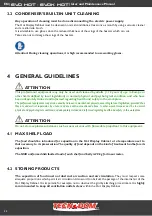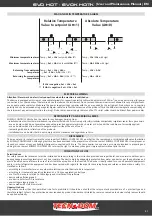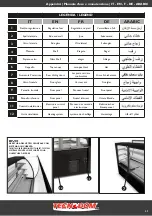
EVO HOT - EVOK HOTK
| User and Maintenance Manual | EN
41
MAX AND MIN TEMPERATURE ALARM
LAL
AFd
HAL
AFd
Setpoint - LAL
AFd
Off
Se HAL
AFd
1
2
Setpoint - LAL + AFd
Setpoint + HAL - AFd
Setpoint
LAL + AFd
HAL - AFd
LAL
AFd
HAL
AFd
Setpoint - LAL
AFd
Off
Se HAL
AFd
1
2
Setpoint - LAL + AFd
Setpoint + HAL - AFd
Setpoint
LAL + AFd
HAL - AFd
Relative Temperature
Value to setpoint (Att=1)
Absolute Temperature
Value (Att=0)
Temp. ≤
Set + LAL
(only with
LAL<0
*)
Temp. ≥
Set + HAL
(only with
HAL>0*
*)
Temp. ≥
Set + LAL + AFd
o
≥
Set -
I
LAL
I
+ AFd
(LAL < 0*)
Temp. ≤
Set + HAL - AFd
(HAL > 0**)
Temp. ≤
LAL
(
LAL
with sign)
Temp. ≥
HAL
(
HAL
with sign)
Temp. ≥
LAL + AFd
Temp. ≤
HAL - AFd
Minimum temperature alarm
Maximum temperature alarm
Returning from minimum
temp. alarm
Returning from maximum
temp. alarm
* if LAL is negative, Set + LAL < Set
** if HAL is negative, Set + HAL > Set
ELECTRICAL WIRING
Attention! Never work on electrical connections when the machine is switched on.
The device is equipped with screw or removable terminals for connecting electric cables with a diameter of 2.5mm
2
(one wire per terminal for power
connections). For the capacity of the terminals, see the label on the instrument. Do not exceed the maximum current allowed; in case of higher loads,
use an appropriate contactor. Make sure the power supply voltage complies with the one required by the instrument. Probes have no connection
polarity and can be extended using a regular bipolar cable (note that the extension of the probes affects the EMC electromagnetic compatibility of
the instrument: pay extreme attention to wiring). Probe cables, power supply cables and the TTL serial cables should be distant from power cables.
RESPONSIBILITY AND RESIDUAL RISKS
ELIWELL CONTROLS SRL shall not be liable for any damages deriving from:
- installation/use other than that prescribed and, in particular, that which does not comply with safety standards anticipated by regulations and/or those given herein;
- use on boards which do not guarantee adequate protection against electric shock, water or dust under the conditions of assembly applied;
- use on boards which allow access to dangerous parts without the use of tools;
- tampering with and/or alteration of the products;
- installation/use on boards that do not comply with the standards and regulations in force.
DISCLAIMER
This manual and its contents remain the sole property of ELIWELL CONTROLS SRL, and shall not be reproduced or distributed without authorization
by ELIWELL CONTROLS SRL. Although great care has been exercised in the preparation of this document, ELIWELL CONTROLS SRL, its employees or
its vendors, cannot accept any liability whatsoever connected with its use. The same applies to any person or company involved in preparing and
editing this document. ELIWELL CONTROLS SRL reserves the right to make any changes or improvements without prior notice.
CONDITIONS OF USE
Permitted use
For safety reasons the instrument must be installed and used according to the instruction provided and in particular, under normal conditions, parts
bearing dangerous voltage levels must not be accessible. The device must be adequately protected from water and dust as per the application and
must also only be accessible via the use of tools (with the exception of the frontlet). The device is ideally suited for use on household equipments
and/or similar refrigeration equipment and has been tested with regard to the aspects concerning European reference standards on safety. It is
classified as follows:
• according to its manufacture: as an automatic electronic control device to be incorporated;
• according to its automatic operating features: as a 1 B-type operated control type;
• as a Class A device in relation to the category and structure of the software;
• device with pollution grade 2;
• as a device with class D fire resistance;
• overvoltage category grade II;
• device made with class IIIa material;
Unpermitted use
Any other use other than that permitted is de facto prohibited. It should be noted that the relay contacts provided are of a practical type and
therefore subject to fault. Any protection devices required by product standards or dictated by common sense due to obvious safety reasons should
be applied externally.














































